Hapusha: Juniperus communis Uses, Research, Remedies, Medicines
Hapusha- Juniperus communis is a plant mentioned in Ayurveda for the treatment for cough, piles, skin diseases, paralysis, erectile dysfunction and earache.
Latin name- Juniperus communis Linn.
Family- Pinaceae ( Sarala kula)
Table of Contents
Vernacular names
Names in different languages:
Hindi name : Aaraar, Haubera, Abhal
English name : Common Juniper, Juniper berry, Juniper plant, Juniper treef
Bengali name : Havusha
Marathi name : Hosha
Punjabi name : Abhal
Persian name : Hab – ul – Bruta
Kashmiri name – Betar, Petthri,Pama,Chui,Haubler
Kumaon : Chichia,Jhora
Deccan :Abhal
Arab : Habbul – Aaraar
French : Geneverier, Cad, Bruta
Catalan : Ginebra
Chamda : Betar
Denmark :Enebaer
Dutch : Genever Boom
German name: Butz Elbeere, Eneber
Greek : Arkevthos
Hungarian : Boroka
Italian : Genebro
Portuguese : Zimbro
Roumanian : Jenuper
Russian :Pojjevelnik
Lahoul : Shama
Kanwar : Langshur
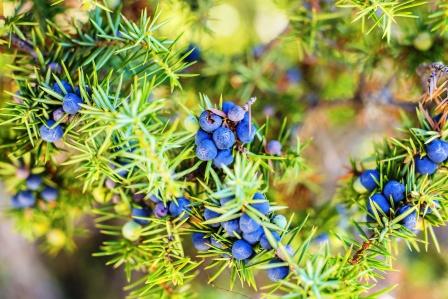
Morphology
Morphology of Juniperus communis Linn:
Juniperus communis Linn a species of evergreen aromatic shrub as tree distributed chiefly in the northern hemisphere from the arctic zone to the mountains of the tropics some of the species furnish commercial woods suitable for pencil making. In India, the plant is found in the Himalayan belt, growing to a height of 10-15 m.
The bark of the tree is thin and brown in color. The leaves are 1-2 cm in length with bluish tinge, with a single white stomatal band on the inner surface. The flowers are unisexual in nature and are seen in the spring season. The fruit are berry-like cones, initially green, ripening in 18 months to purple-black with a blue waxy coating; they are spherical, 4–12 mm (0.16–0.47 in) diameter, and usually have three (occasionally six) fleshy fused scales, each scale with a single seed. Juniper oil is a colorless or pale greenish yellow liquid with a characteristic odor of the fruit a some- what burning bitter flavor. On storing, the oil turns viscous and acquires a turpentine odor.
Properties, part used, dosage
Medicinal properties of Properties:
Rasa (Taste) – Katu (Pungent), Tikta (Bitter)
Guna (Qualities) – Laghu (Light for digestion), Ruksha (Dry in nature), Teekshna (Strong)
Vipaka – Katu (Undergoes pungent taste after digestion)
Veerya (Potency) – Ushna (Hot)
Karma (Actions) – Kaphavata shamaka (reduces vitiated kapha and vata dosha)
Part used- Fruit, Juniper Oil
Dosage-
Powder- 3 to 6 g
Oil- 3 to 4 drops
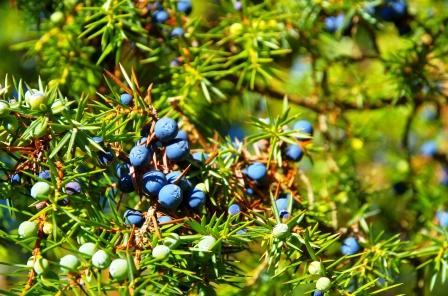
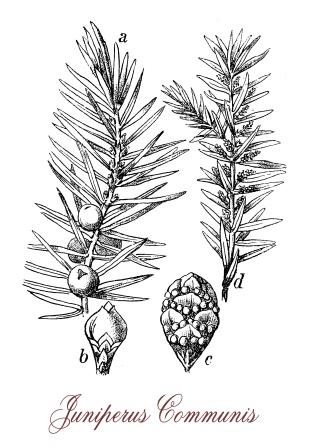
Chemical composition
Chemical composition of Juniperus communis:
The major constituents of the volatile oil are alpha-pinene, sabinene and alpha-terpinene. Methanolic extract of the plant gave several labdane diterpenoids and diterpenes. The leaves contain the biflavones, cupressuflavone, amentoflavone, hinokiflavone, isocryptomerin andsciadopitysin. The berries also contain condensed tannins. Seeds gave haemagglutinin. The berries gave a diterpene ketone, sugrol, beta-sitosterol glucoside and 10-nonacosanol.
Uses of Hapusha:
- The powder of the bark of Hapusha is given in a dose of 2-3 g with honey to treat cough.
- The paste of the bark of Hapusha is applied over the external pile mass and rectal prolapse as part of treatment.
- Decoction prepared from the bark of Juniperus communis is given in a dose of 30-40 ml to treat dysmenorrhea and blood mixed diarrhea.
- The paste of the bark of the tree is applied over wounds and in skin disease as part of treatment.
- Juniper oil of Hapusha is diuretic and carminative in small doses, powerful renal stimulant and diuretic in normal dose. It is stomachic, diuretic and carminative in small doses powerful renal stimulant and diuretic in ordinary doses
- The bitter decoction prepared from the stem of Juniperus communis is given in a dose of 25-30 ml to treat fever and joint pain.
- The paste of the berry and bark of Hapusha is made into paste and applied over the penile region to treat erectile dysfunction.
- In case of intestinal obstruction, buttermilk should be taken with Hapusa, Yavani, cumin seeds and rock salt.
- Cold infusion prepared from the bark of the plant is given in a dose of 30-40 ml as part of treatment in conditions of paralysis, Bell’s palsy etc.
- The fruits of Juniperus communis are used in the alcohol beverage industry for flavoring gin and food products.
Sanskrit verse
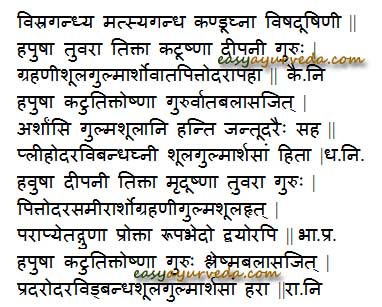
Uses, Indications
Uses of Hapusa as per Ayurveda:
Tuvara – astringent
Deepana – improves digestion strength
Guru – heavy to digest
Indicated in
Kandu – itching, pruritus
Visha – Toxic conditions, poisoning
Grahani – IBS, sprue, altering diarrhea and constipation
Shoola – abdominal colic pain
Gulma – Tumors of the abdomen
Arsha – hemorrhoids
Vataja and Pittaja Udara – ascites, enlargement of the abdomen
jantu – intestinal parasites
Pradara – leucorrhea and heavy periods
Vidbandha – constipation
Adverse effect
No adverse effect is known or reported after the normal use of Hapusha.
Interaction with medicines, supplements
Can this be used while taking Homeopathic medicine?
Yes. This product does not react with homeopathic medicine.
Can this medicine be continued while taking supplements like multivitamin tablets, Omega 3 fatty acids etc?
Yes. Generally, this product goes well with most dietary supplements. However, if you are taking more than one product per day, please consult your doctor for an opinion.
With western
medicines
Seek your
doctor’s advice if you are taking this product along with other western
(allopathic / modern) medicines. Some Ayurvedic herbs can interact with modern
medicine.
If both Ayurvedic and allopathic medicines are advised together, then it is
best to take Allopathic medicine first, wait for 30 minutes and then take the
Ayurvedic medicine.
Ayurvedic medicines
Ayurvedic medicines containing Hapusha:
Eranda paka: It is an Ayurvedic medicine in lehya form. It is mainly used in the treatment of Vata diseases, abdominal colic pain, bloating, edema, inflammation, ascites, urinary tract diseases, rheumatoid arthritis etc.
Nityananda Rasa: It is an Ayurvedic medicine in tablet form, used in treatment of gout, piles, lymphadenitis, tumors, obesity, elephantiasis, etc.
Chavikasava: It is an Ayurvedic medicine used mainly in abdominal and urinary tract disorders. It is a liquid medicine having self -generated alcohol.
Kumaryasava: It is a liquid Ayurvedic medicine used in the treatment of gastritis, urinary tract disorders, piles, respiratory conditions like cough, cold, wheezing etc.
Pradarantak loha: It is an Ayurvedic medicine in tablet or powder form. It is mainly used in the treatment of menorrhagia, metrorrhagia, leucorrhea etc.
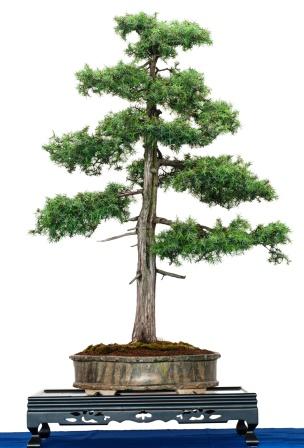
Vastyamayantaka ghrita: It is used for preparatory procedure for Panchakarma and also as medicine, used in the treatment of diseases related to the urinary system.
Research
Research articles related to Juniperus communis:
Neuro-protective effect: We evaluated anti-Parkinson’s activity of methanolic extract of Juniperus communis (MEJC) leaves in chlorpromazine (CPZ) induced experimental animal model. The experiment was designed, by giving chlorpromazine (3 mg/kg, i.p.) for 21 days to induce Parkinson’s disease-like symptoms. The MEJC significantly reduced catalepsy and muscle rigidity and significantly increased locomotor activity in rats.
Hepato- protective action: In the present study, the antioxidant, cytotoxic and hepato protective activities of Juniperus communis leaves were investigated against various models. EAF of J. communis leaves is found to be potent antioxidant and hepato protective without any cytotoxicity and it can also be included in nutraceuticals with notable benefits for mankind or animal health.
Anti- microbial activity: Methanolic extracts of two Indian medicinal plants Juniperus communis and Solanum xanthocarpum, were examined for their antimicrobial potential against selected bacteria and fungi. The results showed that alcoholic extract possesses excellent antimicrobial activity against selected test bacteria and fungi.
Fungicidal action: the study involved an evaluation of antifungal activity in vitro of 1.0; 0.5; 0.1 mm3 ·cm-3 juniper oil with respect to above mentioned fungi. In laboratory conditions, regardless of the concentration, juniper oil strongly inhibits the linear growth and sporulation of fungi, the most intensively colonizing horseradish seedlings.
Therapeutic uses
Arsha – Citraka, Hapusa & Hingu shall be taken with Takra (Ref: C.S.Ci 14)
Gulma – Hapusadi Ghrita – Ref: C.S.Ci 71 – 73.
Baddhodara – Hapusa, Yavani, Jiraka and Rock salt may be given along with butter milk. (Ref: C.Ci 13)
Yapana basthi – C.S.Si 12/15
Hapusha and barley powder is cooked in milk and water. Ksheerapaka is prepared. It is added with honey, ghee, oil, and salt and administered as enema Ksheerabasti. It alleviates Vata and debility and promotes intellect, digestion and strength (C.S.Si 7/12 – 15)
In case of intestinal obstruction, buttermilk should be taken with Hapusa, Yavani, jiraka and rock salt – Charaka Chikitsa Sthana, 13/15
Classical categorization
Bhavaprakasha Nighantu -Haritakyadi varga
Kaiyyadeva Nighantu – Oushadi varga
Raja Nighantu – Shatahvadi varga
Scientific classification
Kingdom: Plantae
Division: Pinophyta
Class: Pinopsida
Order: Pinales
Family: Cupressaceae
Genus: Juniperus
Species: J. communis
Sanskrit synonyms
Vipusha,
Atigandhika, Dhvanksha Nasika, Visra, Vigandhika, Vigandhya,Matsyagangha, – having bad smell of a fish
Raktamundini,
Asvathaphala – fruits resemble that of Ashwattha fruits
Pleehahantri – useful in spleen disorders
Visha Dushini, Visaghni – anti toxic
Kaphagni – balances Kapha Dosha
Yakrut Varna – fruits having colour of liver
Kulanashini, Kacchughma
Habitat
Britain, North America and Asia. Grows in temperate regions from Kashmir to Uttaranchal at an altitude of 3000-4500 mt. Juniper tree and several species, there of are common on the North west of the Himalaya’s kumaon and Kurram valleys and Persia.
Author: Dr.B.K.Prashanth M.D (Ayu), Ph.D
E mail: [email protected]
Click to consult Dr Prashanth BK
Sthanika Karma (Systemic Action)
External Application – It possesses Scraping, Anti inflammatory, Wound healing and Stimulant actions. Its paste is used externally in erectile dysfunction. In hearing loss its juice is used as ear drops. In painful inflammatory wounds / skin lesions its paste can be used for external application.
Internal administration-
Nervous system – Nervous stimulant, Indicated in Hemiplegia, paraplegia conditions.
Digestive System – Carminative, absorbent and Anthelmintic in nature. Facilitate normal movement of doshas. Indicated in Indigestion, malabsorption syndrome, Helminthiasis, Abdominal colic, Hemorrhoids etc.
Circulatory System – Cardiac stimulant
Respiratory system – Expels out vitiated kapha dosha. Indicated cough, Asthma etc.
Reproductive system – Induce menstruation, indicated in inflammatory diseases associated with female reproductive tract and uterus. Overdose can cause abortion in pregnant ladies. indicated in Amenorrhea, Leukorrhea, Dysmenorrhea etc.
Excretory system – Increase urine output. Overdose can cause hematuria. Indicated in Urinary tract infections
Tvak – Increases sweat production











2 comments
Vd. Prajakta Deval
excellent research sir . thank you. as it is not common ly seen in maharashtra, i am glad to read your compilation .
Dr J V Hebbar MD(Ayu)Author
Welcome 🙂